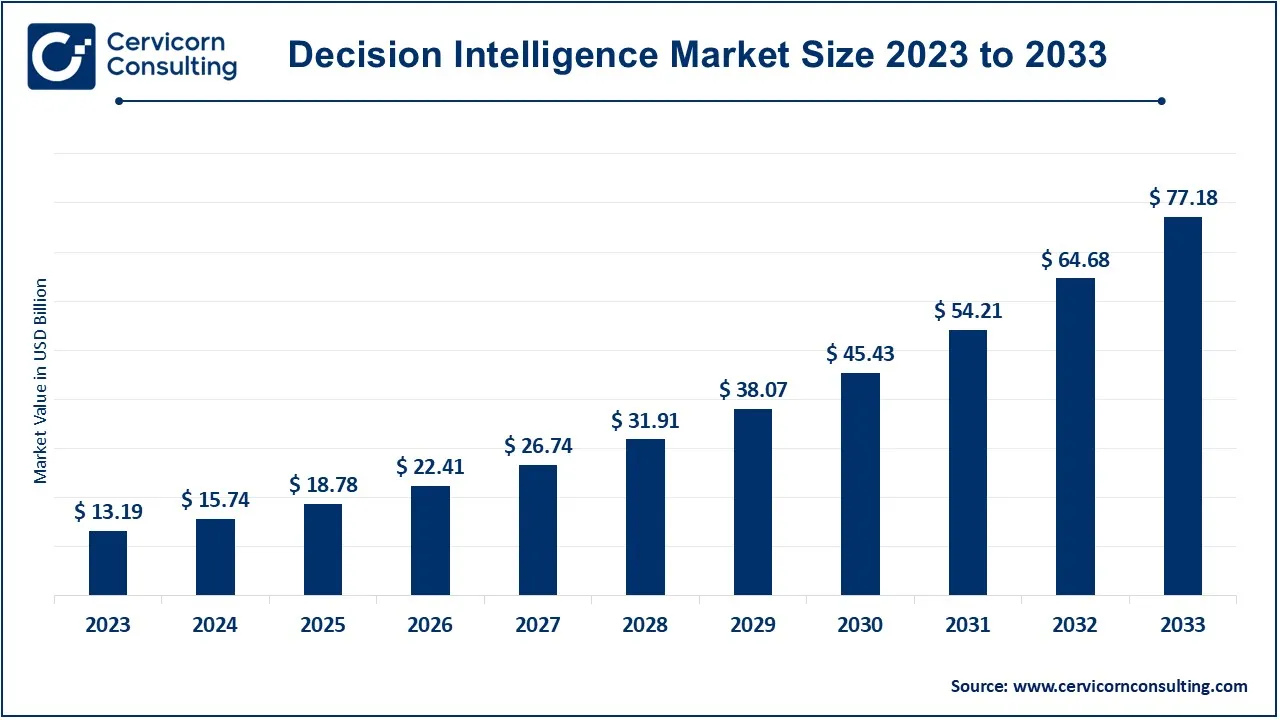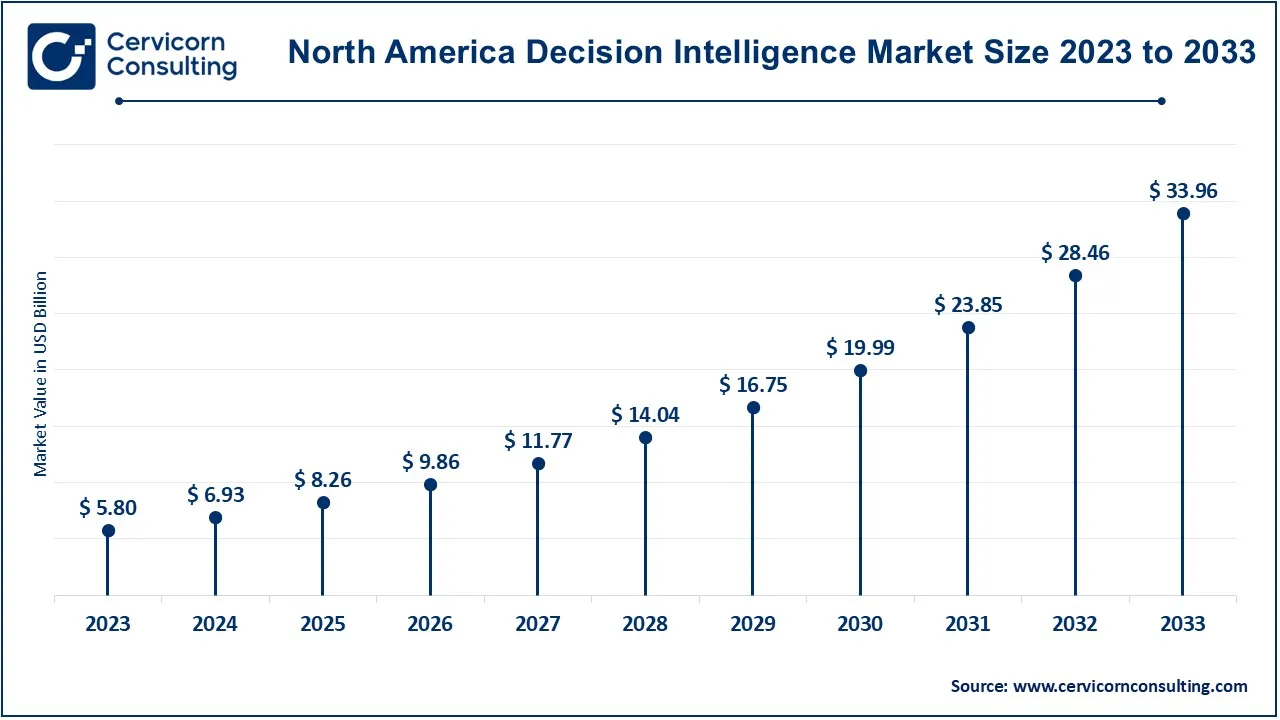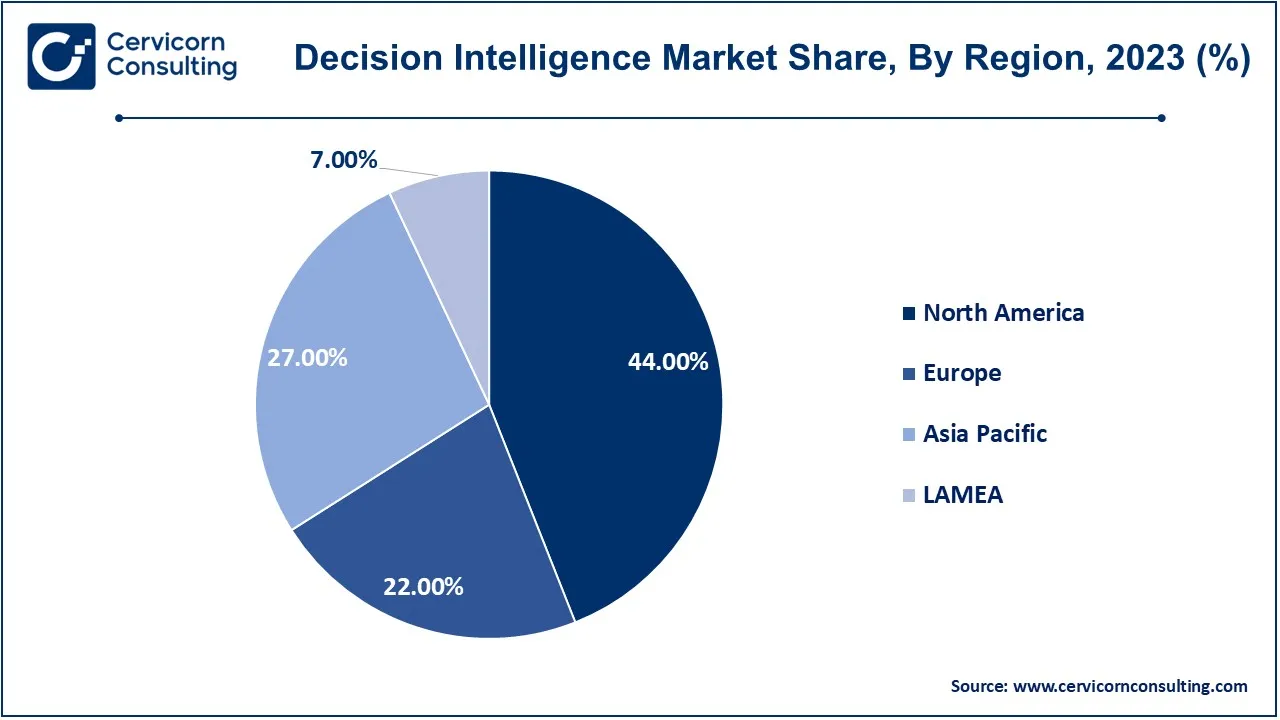The global decision intelligence market size was valued at USD 15.74 billion in 2024 and is expected to be worth around USD 77.18 billion by 2033, growing at a compound annual growth rate (CAGR) of 19.32% from 2024 to 2033.
The decision intelligence (DI) market is experiencing significant growth, driven by the increasing need for businesses to adopt data-driven approaches to make complex decisions. As organizations face an influx of data from various sources, traditional decision-making methods often fall short of extracting valuable insights. The integration of AI, machine learning, and analytics into decision-making processes has emerged as a game-changer for many industries. The market for DI is projected to expand rapidly, with a growing demand for tools that can optimize business operations and enhance strategic decision-making. As of recent trends, industries such as finance, healthcare, and retail are investing heavily in decision intelligence to stay competitive. Financial institutions use DI to optimize investment strategies and reduce risks, while healthcare providers use it to improve patient outcomes and streamline operations.

Decision intelligence (DI) is an emerging field that combines artificial intelligence (AI), machine learning, data analytics, and traditional decision-making frameworks to help organizations make better, data-driven decisions. It enables organizations to apply data and advanced analytics to real-world problems, enhancing decision-making processes. DI integrates predictive models, simulations, and optimization techniques to generate actionable insights and recommendations. It empowers decision-makers to make choices that are not only based on past data but also consider future possibilities and outcomes. By integrating various data sources and applying AI, DI provides a holistic approach to problem-solving, making it easier to navigate complex situations and optimize outcomes.
Report Scope
| Area of Focus | Details |
| Market Size in 2025 | USD 18.78 Billion |
| Estimated Market Size in 2033 | USD 77.18 Billion |
| Growth Rate 2024 to 2033 | 19.32% |
| Most Prominent Region | North America |
| Fastest Expanding Area | Asia-Pacific |
| Key Segments | Component, Type, Organization Size, Enterprise Type, Industry Verticals, Region |
| Key Companies | Google, IBM, Oracle, Microsoft, Clarifai, Paretos, Pace Revenue, Metaphacts, Diwo.ai, Provenir |
The decision intelligence market is segmented into component, type, organization size, enterprise type, industry verticals and region. Based on component, the market is classified into platform, solutions, and services. Based on type, the market is classified into decision automation, decision augmentation, and decision support systems (DSS). Based on organization size, the market is classified into marketing & sales, finance & accounting, human resources, operations, research & development. Based on enterprise type, the market is classified into large enterprises, and small & medium enterprises. Based on industry verticals, the market is classified into energy and utilities, BFSI, IT and telecom, government, healthcare, manufacturing, retail and consumer goods, others.
Based on component, the global market is segmented into platforms, solution and services.
Platforms: The underpinning DI platforms bring a consortium of several data sources, analytic capabilities, and AI algorithms. They furnish the user with the scaffolding to obtain, analyze, and display data, thus allowing organizations to substantiate their material decisions expeditiously and efficiently.
Solutions: DI solutions comprise targeted applications aimed at meeting various unique business challenges. These solutions use advanced analytics and artificial intelligence to give organizations the insight and recommendations to optimize processes, enhance performance, and improve decision-making across many functional areas.
Services: The decision intelligence industry services, such as consultation, implementations, and support services. These services help organizations adopt DI solutions and integrate them throughout their practice by providing expertise on data strategy, model development, and ongoing maintenance to ensure maximum performance and value realization.
Based on industry vertical, the global market is segmented into energy and utilities, banking, finance service, & insurance, IT and telecommunication, government, retail and consumer goods, healthcare and other. The healthcare segment has dominated the market in 2023.
Energy and utilities: This sector employs DI to better manage resources, forecast demand more effectively, and stream-lining grid management. Proper analytics would provide operational assistance for operational efficiency, cost savings, and development of sustainable practices in the utility industry.
Banking, Finance Service, and Insurance: Within the scope of BFSI, DI is widely adopted to facilitate risk assessment, fraud detection, and client relationship management. Using massive amounts of data analysis allows companies to make data-driven decisions that improve upon their financial performance and regulatory compliance through interventions and activities such as those.
IT and telecommunication: DI in the sectors of IT and telecom takes on enhancing network performance, augmenting customer experiences, and managing resources more effectively. Real-time analytics, when incorporated into IT and telecom applications, see improved service delivery, network outage prediction, and opportunities for innovation.
Government: Within governmental operations, DI serves to improve public services and resource management into the effective service of better policymaking. Because data-driven information gives officials more confidence in serving a community's needs, it also ensures the accountability and transparency of such actions.
Health: DI within the health sector is aimed at optimizing clinical decision-making therapy and operations. Using patient data plus analysis of treatment outcomes, health providers may enhance their treatment approaches while cutting costs and, furthermore, keeping their patients satisfied.
Retail and Consumer Goods: The retail and consumer goods sector clearly gains in decision intelligence: insights into consumer trends, management of the supply chain, and best marketing strategies. The information from this insight helps companies adjust the user experience and sales performance.
Others: This course involves decision Intelligence that different industries employ to address a specific challenge. Logistics, education, and agriculture depend on data analytics in support of better decision modalities, improvement in operation, and pushing their respective sphere of innovation.
The decision intelligence market is segmented into several key regions: North America, Europe, Asia-Pacific, and LAMEA (Latin America, Middle East, and Africa). The North America has dominated the market in 2023. Here’s an in-depth look at each region.
The North America decision intelligence market size was estimated at USD 5.80 billion in 2023 and is expected to reach around USD 33.96 billion by 2033. Technology infrastructure and the growing adoption of AI and analytics solutions are the major drivers for the region’s growth. Consequently, the US is a key market with many players in data analytics, predictive analytics, and applications of machine learning in various verticals. On the other hand, Canada plays a significant role due to heavy investments in AI R&D. Stronger government support for innovation and technology will complement the growing thirst for data-led decision-making in the BFSI, healthcare, and IT sector.

The Europe decision intelligence market size was valued at USD 2.90 billion in 2023 and is projected to hit around USD 16.98 billion by 2033. Europe is witnessing a really fast growth, which is attributed to the many regulations as well as an increasing emphasis on data privacy. The major actors in the market such as Germany, the UK, and France are taking the lead by adopting advanced analytics and AI solutions to improve their business processes. Decision intelligence is driven particularly by the trajectories of digital transformations in various sectors, with the automotive, healthcare, and finance industries being in the vanguard. However, with the increasing focus on the ethical practices of AI among European firms, the market becomes competitive, which further emboldens collaborations among corporations, research institutions, and government agencies.
The Asia-Pacific decision intelligence market size was valued at USD 3.56 billion in 2023 and is predicted to surpass around USD 20.84 billion by 2033. The Asia Pacific is on its way to become the most prolific new entrant in the market, riding high on economic development and increased investment in technology. The championing countries-China, India, and Japan-are already in the race, with a fast-growing number of startups and incumbents using AI and data analytics to enhance their decision-making process. The various industries working on the digital transformation are adopting decision intelligence solutions. Amongst other segments receiving benefits are manufacturing, retail, finance, and thus making competitive advantage and improved efficiency. Further governmental initiative promoting digital innovation in this region is also catalyzing market development.

The LAMEA decision intelligence market size was valued at USD 0.92 billion in 2023 and is expected to be worth around USD 5.40 billion by 2033. Gradually, countries like Brazil, Mexico, and South Africa are venturing into market. The market is driven by the demand for operational efficiency and understanding of the customers' demands in retail, healthcare, and finance. In parts of the Middle East, such as UAE and Saudi Arabia, investments in digital transformation initiatives propel the adoption of market. However, despite existing challenges such as issues with data quality and database management; there, however, lies a large potential for growth within this region, where organizations intend to leverage data-driven insights for strategic decision-making.
The market of DI in general, is clouded with a handful of major players such as Google, IBM, Oracle, Microsoft, Clarifai, and others. These companies leverage their robust technological infrastructures and extensive expertise in AI and machine learning to provide comprehensive decision intelligence solutions. Google and Microsoft focus on integrating AI capabilities into their cloud platforms, enhancing data analytics and machine learning functionalities. IBM offers sophisticated analytics and business intelligence tools that empower organizations to make informed decisions based on real-time data. Oracle specializes in providing data-driven insights tailored to various industries, while clarifai focuses on visual recognition and AI models for specific applications.
CEO Statements
Arvind Krishna, CEO of IBM
Satya Nadella, CEO of Microsoft
Safra A. Catz, CEO of Oracle
Some notable examples of key developments in the decision intelligence sector include:
These developments highlight significant advancements in the market, showcasing innovative technologies that enhance efficiency, optimize decision-making, and automate complex business processes. Major players like IBM, Google, and Oracle are driving this shift by integrating AI and machine learning tools into their cloud infrastructures. IBM's, Watsonx.ai, for instance, aims to scale AI deployment with governance, while Google Cloud’s Vertex AI and Oracle’s AI services facilitate real-time decision-making using advanced analytics. This innovation is empowering industries across sectors such as healthcare, finance, and retail, enabling faster, data-driven decisions with improved accuracy.
Market Segmentation
By Component
By Type
By Organization Size
By Enterprise Type
By Industry Verticals
By Region
Chapter 1. Market Introduction and Overview
1.1 Market Definition and Scope
1.1.1 Overview of Decision Intelligence
1.1.2 Scope of the Study
1.1.3 Research Timeframe
1.2 Research Methodology and Approach
1.2.1 Methodology Overview
1.2.2 Data Sources and Validation
1.2.3 Key Assumptions and Limitations
Chapter 2. Executive Summary
2.1 Market Highlights and Snapshot
2.2 Key Insights by Segments
2.2.1 By Component Overview
2.2.2 By Type Overview
2.2.3 By Organization Size Overview
2.2.4 By Enterprise Type Overview
2.2.5 By Industry Verticals Overview
2.3 Competitive Overview
Chapter 3. Global Impact Analysis
3.1 COVID 19 Impact on Decision Intelligence Market
3.1.1 COVID-19 Landscape: Pre and Post COVID Analysis
3.1.2 COVID 19 Impact: Global Major Government Policy
3.1.3 Market Trends and Opportunities in the COVID-19 Landscape
3.2 Russia-Ukraine Conflict: Global Market Implications
3.3 Regulatory and Policy Changes Impacting Global Markets
Chapter 4. Market Dynamics and Trends
4.1 Market Dynamics
4.1.1 Market Drivers
4.1.1.1 Data-Driven Culture
4.1.1.2 The Emergence of Advanced Analytics
4.1.1.3 Increased Investment in AI
4.1.2 Market Restraints
4.1.2.1 High Implementation Expenditures
4.1.2.2 Data Privacy Issues
4.1.2.3 Skills Shortage
4.1.3 Market Challenges
4.1.3.1 Data Quality Management
4.1.3.2 Scalability
4.1.3.3 Change Management
4.1.3.4 Market Saturation
4.2 Market Trends
Chapter 5. Premium Insights and Analysis
5.1 Global Decision Intelligence Market Dynamics, Impact Analysis
5.2 Porter’s Five Forces Analysis
5.2.1 Bargaining Power of Suppliers
5.2.2 Bargaining Power of Buyers
5.2.3 Threat of Substitute Products
5.2.4 Rivalry among Existing Firms
5.2.5 Threat of New Entrants
5.3 PESTEL Analysis
5.4 Value Chain Analysis
5.5 Product Pricing Analysis
5.6 Vendor Landscape
5.6.1 List of Buyers
5.6.2 List of Suppliers
Chapter 6. Decision Intelligence Market, By Component
6.1 Global Decision Intelligence Market Snapshot, By Component
6.1.1 Market Revenue (($Billion) and Growth Rate (%), 2021-2033
6.1.1.1 Platform
6.1.1.2 Solutions
6.1.1.3 Services
Chapter 7. Decision Intelligence Market, By Type
7.1 Global Decision Intelligence Market Snapshot, By Type
7.1.1 Market Revenue (($Billion) and Growth Rate (%), 2021-2033
7.1.1.1 Decision automation
7.1.1.2 Decision Augmentation
7.1.1.3 Decision Support Systems (DSS)
Chapter 8. Decision Intelligence Market, By Organization Size
8.1 Global Decision Intelligence Market Snapshot, By Organization Size
8.1.1 Market Revenue (($Billion) and Growth Rate (%), 2021-2033
8.1.1.1 Marketing & Sales
8.1.1.2 Finance & Accounting
8.1.1.3 Human Resources
8.1.1.4 Operations
8.1.1.5 Research & Development
Chapter 9. Decision Intelligence Market, By Enterprise Type
9.1 Global Decision Intelligence Market Snapshot, By Enterprise Type
9.1.1 Market Revenue (($Billion) and Growth Rate (%), 2021-2033
9.1.1.1 Large Enterprises
9.1.1.2 Small & Medium Enterprises
Chapter 10. Decision Intelligence Market, By Industry Verticals
10.1 Global Decision Intelligence Market Snapshot, By Industry Verticals
10.1.1 Market Revenue (($Billion) and Growth Rate (%), 2021-2033
10.1.1.1 Energy and Utilities
10.1.1.2 BFSI
10.1.1.3 IT and Telecom
10.1.1.4 Government
10.1.1.5 Healthcare
10.1.1.6 Manufacturing
10.1.1.7 Retail and Consumer Goods
10.1.1.8 Others
Chapter 11. Decision Intelligence Market, By Region
11.1 Overview
11.2 Decision Intelligence Market Revenue Share, By Region 2023 (%)
11.3 Global Decision Intelligence Market, By Region
11.3.1 Market Size and Forecast
11.4 North America
11.4.1 North America Decision Intelligence Market Revenue, 2021-2033 ($Billion)
11.4.2 Market Size and Forecast
11.4.3 North America Decision Intelligence Market, By Country
11.4.4 U.S.
11.4.4.1 U.S. Decision Intelligence Market Revenue, 2021-2033 ($Billion)
11.4.4.2 Market Size and Forecast
11.4.4.3 U.S. Market Segmental Analysis
11.4.5 Canada
11.4.5.1 Canada Decision Intelligence Market Revenue, 2021-2033 ($Billion)
11.4.5.2 Market Size and Forecast
11.4.5.3 Canada Market Segmental Analysis
11.4.6 Mexico
11.4.6.1 Mexico Decision Intelligence Market Revenue, 2021-2033 ($Billion)
11.4.6.2 Market Size and Forecast
11.4.6.3 Mexico Market Segmental Analysis
11.5 Europe
11.5.1 Europe Decision Intelligence Market Revenue, 2021-2033 ($Billion)
11.5.2 Market Size and Forecast
11.5.3 Europe Decision Intelligence Market, By Country
11.5.4 UK
11.5.4.1 UK Decision Intelligence Market Revenue, 2021-2033 ($Billion)
11.5.4.2 Market Size and Forecast
11.5.4.3 UK Market Segmental Analysis
11.5.5 France
11.5.5.1 France Decision Intelligence Market Revenue, 2021-2033 ($Billion)
11.5.5.2 Market Size and Forecast
11.5.5.3 France Market Segmental Analysis
11.5.6 Germany
11.5.6.1 Germany Decision Intelligence Market Revenue, 2021-2033 ($Billion)
11.5.6.2 Market Size and Forecast
11.5.6.3 Germany Market Segmental Analysis
11.5.7 Rest of Europe
11.5.7.1 Rest of Europe Decision Intelligence Market Revenue, 2021-2033 ($Billion)
11.5.7.2 Market Size and Forecast
11.5.7.3 Rest of Europe Market Segmental Analysis
11.6 Asia Pacific
11.6.1 Asia Pacific Decision Intelligence Market Revenue, 2021-2033 ($Billion)
11.6.2 Market Size and Forecast
11.6.3 Asia Pacific Decision Intelligence Market, By Country
11.6.4 China
11.6.4.1 China Decision Intelligence Market Revenue, 2021-2033 ($Billion)
11.6.4.2 Market Size and Forecast
11.6.4.3 China Market Segmental Analysis
11.6.5 Japan
11.6.5.1 Japan Decision Intelligence Market Revenue, 2021-2033 ($Billion)
11.6.5.2 Market Size and Forecast
11.6.5.3 Japan Market Segmental Analysis
11.6.6 India
11.6.6.1 India Decision Intelligence Market Revenue, 2021-2033 ($Billion)
11.6.6.2 Market Size and Forecast
11.6.6.3 India Market Segmental Analysis
11.6.7 Australia
11.6.7.1 Australia Decision Intelligence Market Revenue, 2021-2033 ($Billion)
11.6.7.2 Market Size and Forecast
11.6.7.3 Australia Market Segmental Analysis
11.6.8 Rest of Asia Pacific
11.6.8.1 Rest of Asia Pacific Decision Intelligence Market Revenue, 2021-2033 ($Billion)
11.6.8.2 Market Size and Forecast
11.6.8.3 Rest of Asia Pacific Market Segmental Analysis
11.7 LAMEA
11.7.1 LAMEA Decision Intelligence Market Revenue, 2021-2033 ($Billion)
11.7.2 Market Size and Forecast
11.7.3 LAMEA Decision Intelligence Market, By Country
11.7.4 GCC
11.7.4.1 GCC Decision Intelligence Market Revenue, 2021-2033 ($Billion)
11.7.4.2 Market Size and Forecast
11.7.4.3 GCC Market Segmental Analysis
11.7.5 Africa
11.7.5.1 Africa Decision Intelligence Market Revenue, 2021-2033 ($Billion)
11.7.5.2 Market Size and Forecast
11.7.5.3 Africa Market Segmental Analysis
11.7.6 Brazil
11.7.6.1 Brazil Decision Intelligence Market Revenue, 2021-2033 ($Billion)
11.7.6.2 Market Size and Forecast
11.7.6.3 Brazil Market Segmental Analysis
11.7.7 Rest of LAMEA
11.7.7.1 Rest of LAMEA Decision Intelligence Market Revenue, 2021-2033 ($Billion)
11.7.7.2 Market Size and Forecast
11.7.7.3 Rest of LAMEA Market Segmental Analysis
Chapter 12. Competitive Landscape
12.1 Competitor Strategic Analysis
12.1.1 Top Player Positioning/Market Share Analysis
12.1.2 Top Winning Strategies, By Company, 2021-2023
12.1.3 Competitive Analysis By Revenue, 2021-2023
12.2 Recent Developments by the Market Contributors (2023)
Chapter 13. Company Profiles
13.1 Google
13.1.1 Company Snapshot
13.1.2 Company and Business Overview
13.1.3 Financial KPIs
13.1.4 Product/Service Portfolio
13.1.5 Strategic Growth
13.1.6 Global Footprints
13.1.7 Recent Development
13.1.8 SWOT Analysis
13.2 IBM
13.3 Oracle
13.4 Microsoft
13.5 Clarifai
13.6 Paretos
13.7 Pace Revenue
13.8 Metaphacts
13.9 Diwo.ai
13.10 Provenir